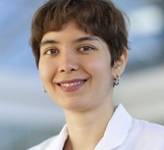Molecular Testing in 2014: Where We Are
Several factors affect physicians’ choice of genomic tests, including availability, speed, and cost. Traditionally allelotyping have been used, since they are fast and sensitive, even though they are not comprehensive.
Juneko Grilley-Olson, MD

While the ASCO 2014 session titled “How to Talk With Your Pathologist About Molecular Testing” was ostensibly a lung cancer session, this is a topic that is really quite applicable across all of oncology. Dr. Pasi Jänne started by giving an overview, saying that the guidelines written by CAP/IASLC/AMP recommend that molecular testing be performed in all patients with advanced non–small-cell lung cancer (NSCLC)-and the NCCN guidelines similarly recommend testing, although for squamous cell lung cancer the guidelines only ‘recommended to consider’ testing. Unfortunately, only two of lung cancer’s much-discussed molecular subsets have approved molecularly directed therapies: EGFR and ALK.
Several factors affect physicians’ choice of genomic tests, including availability, speed, and cost. Traditionally allelotyping (assays to detect a specific predefined mutation) have been used, since they are fast and sensitive, even though they are not comprehensive. There are two approved tests for EGFR: cobas (erlotinib) and therascreen (afatinib). While similar, they test different numbers of less-common EGFR mutations, and some exon 19 insertions are not picked up by these tests.
Sequencing, on the other hand, permits the analysis of DNA changes to specific regions of a gene or genome. Compared with allelotyping assays, it is comprehensive, but it can have lower sensitivity and be slow. Conventional Sanger sequencing synthesizes complementary standard strand fragments and involves the analysis of the fragments on a gel or Western blot. It’s somewhat analogous to an analog process. In contrast, next generation sequencing (NGS) is the comparable digital process that allows massive parallel sequencing, which enables one to look at point mutations, insertions/deletions, copy number alterations, translocations, and pathogens. NGS is ultimately likely to be more cost effective (roughly $1,500, compared to individual assays for EGFR, ALK, ROS, RET, MET, ERBB2, and FGFR which can cost about $5,000).
The subtypes of NGS include whole-genome, whole-exome, and targeted capture sequencing, and each has its strengths and weaknesses. Whole-genome, which covers 100% of the genome, is expensive, requires matched normal, and has low depth of coverage, but is useful for discovery purposes. Whole exome “only” captures 1% of the genome (~25,000 genes), needs matched normal, and as analytical complexity increases so does its cost. Targeted capture only covers select, prespecified genes/hotspots of genes, but has low cost and high coverage. Here you may not have to do matched normal (although at my own institution, we have seen commercial results report somatic mutations such as BRCA1/2 that are, in fact, germline). Analytic interpretive complexity is much lower, which is useful for clinical testing but not discovery.
Dr. Jänne described Dana-Farber’s standard clinic algorithm. For a treatment-naive patient, they do rapid EGFR, ALK, ROS1 IHC (48–72 hours) in parallel with sending their in-house NGS panel, which includes 275 genes, 30 gene rearrangements, and has a turn-around time of 2 to 3 weeks. If the patient is currently in treatment, they only send NGS. He described how NGS can help clarify diagnostic dilemmas via the discovery of pathognomonic findings, citing a neuroendocrine NSCLC consult that was redesignated as a Ewing sarcoma. He also explained how NGS can be used to suggest treatment opportunities, and described a case in which identification of an EGFR amplification in a quintuple (EGFR, ALK, ROS1, BRAF, MET)-negative NSCLC patient suggested a therapeutic trial of erlotinib, which turned out to be clinically beneficial in inducing a minor response in a patient.
As mentioned above, when you start sequencing, you can find incidental germline mutations. American College of Medical Genetics has recommendations for reporting this to patient/families.
Dr. Jänne ended his talk by predicting that soon we will have noninvasive testing for genotyping that will use patient plasma to extract DNA and sequence. In this way, we will hopefully better understand cancer etiology by, for example, making it possible to follow the evolution of EGFR mutation over time.
Neoadjuvant Capecitabine Plus Temozolomide in Atypical Lung NETs
Read about a woman with well-differentiated atypical carcinoid who experienced a 21% regression in primary tumor size after 12 months on neoadjuvant capecitabine and temozolomide.